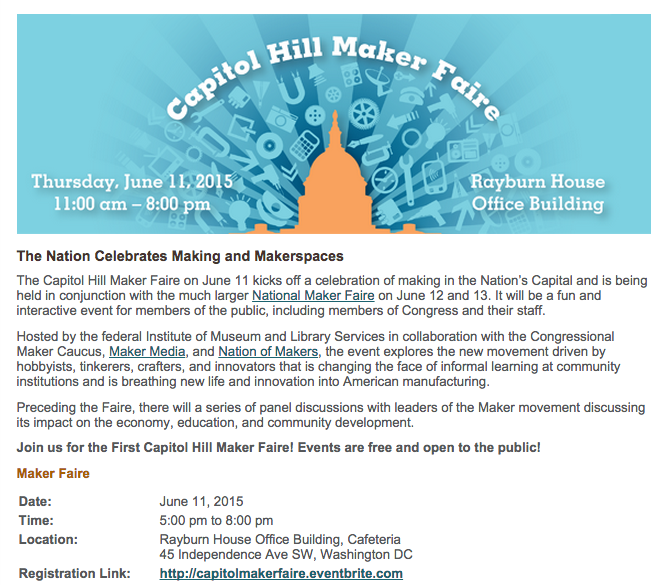We are back from a whirlwind few days at the Capitol Hill and National Maker Faires. It was a great opportunity to see some familiar faces, meet some new ones, and consider the many organizations, companies, and not-for-profit groups working broadly in the maker movement. I am grateful to everyone at IMLS, Make Media, the conference co-sponsor Cognizant, the Congressional Maker Caucus, and the office of Congressman Mark Takano (especially deputy chief of staff Yuri Beckelman). Special thanks as well to the U-M Government Relations office for their invaluable support.
It was a great time, full of optimism and good wishes. A good event, in my mind, is one where you walk away with a greater awareness of your program’s strengths and areas of improvement, gather new ideas (many of which I posted to Twitter), and find yourself tugging with Big Questions and tensions that keep you thinking long after the panels are completed, the robots packed up, and the sunscreen put away.
Despite the excitement and enthusiasm, there were some overarching questions that lingered in my mind:
- There is so much pleasure in talking with others who have mentoring/guiding roles in maker communities, especially with kids. How do we keep those connections going, when making seems to be understaffed and its proponents so busy?
- I think there’s a quiet but insistent tension as the maker movement grows: from makers who defined themselves as unique-from-the-norm (e.g., “outsiders” or “outliers”; defined by difference) to everybody-is-a-maker (mainstream; defined by similarities.) See, for example, Michaels Crafts stores’ “Make Market” campaign or the Chrysler 200 “Born Makers” campaign (which, as a Michigander, I’m predisposed to like). Is it possible that a growth in the maker movement could lead to disenfranchisement of its early adopters? Corollary: Who “owns” the movement?
- I heard one question bubbling up between panels and realized that one of the questions among long-term self-identified makers is this: how do we balance the maker movement’s roots as a ground-up movement with the maker initiatives of government, industry, schools, libraries, museums, scouts, etc., all of whom have institutional authority behind their initiatives that could alter the “purity” (for lack of a better word) of the movement’s origins? (For a sense of the breadth I’m talking about, see yesterday’s White House fact sheet on the Week of Making and a smattering of the organizations involved and commitments made.)
- What happens when making moves into new disciplines (e.g., libraries, education, museums) that have their own disciplinary values and constraints that might be different from the “hackers in a garage” of years ago? For example, how do documents like the ALA Code of Ethics fit in? Will there be disparate needs?
- Is there room for all in the maker movement five years from now? Or will making slowly codify into a set of accepted practices/tools/personalities?
- How do we identify best/effective practices to support those just getting started while holding onto the ideals of agency and choice for makers? In other words, how do we balance helpful guidance with the risk of over-codification?
- How do we move making/DIY/handmade/artisanal practice from fad to something sustainable on a large level? (Related question: where does the money come from in underserved communities?)
- How do makers talk among one another vs. to external constituencies? What gets forefronted, what gets left out, and what are the benefits/costs of those decisions?
- How do we resolve the “what counts as making” question? A colleague over dinner posited that to Bedazzle clothing is not making — it wasn’t transformative enough. Well, I’m not personally a fan of Bedazzling, and I tend to agree with her. At the same time, who gets to judge whether something counts? (This is particularly critical since there are social/class stereotypical assumptions that go along with Bedazzling — it’s not exactly an Upper East Side activity.) What happens if we tell Aunt Edna that her latch hook kit doesn’t count (even though, if you ask me, that falls just shy of making)? What is the price we pay for that exclusion? And how do these mental models interact with government policy, funding streams, etc.? Similarly, some in the maker movement are firmly rooted in making as a pathway to self-awareness, self-soothing, or executive function. Others extrapolate beyond the individual to social justice or improved access; others in making as a pathway to greater economic/corporate profit. Some see making as an extension of the recycling movement: a chance to hack, remake, alter, and adjust existing materials so as to reduce the overall environmental impact of individuals.
- Said more plainly: almost everyone who has a leading role in a makerspace talks about how popular needle arts are, primarily sewing and knitting. But among corporate and political speakers, this almost never comes up. What are the implications?
- How soon until we can get started with a new year of making with our after-school partners? We have lots of new ideas to share and float out to our makers, and lots of new conversations to have back home!


Pingback: Capitol Hill Maker Faire Follow-Up | MakerBridge